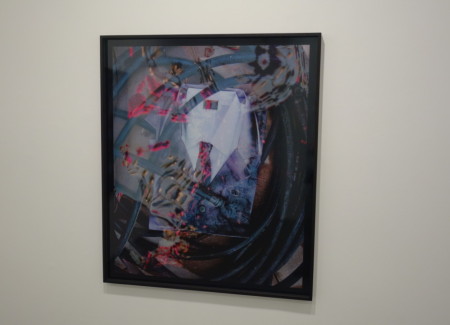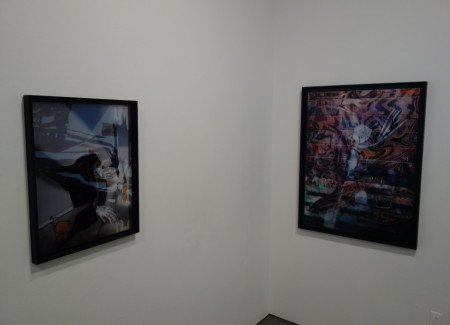JTF (just the facts): A total of 6 large scale color photographs, framed in black and unmatted, and hung against white walls in a small single room gallery space. All of the works are c-prints, made in 2015. Physical sizes range from roughly 28×22 to 50×38, and each image is available in an edition of 3. (Installation shots below.)
Comments/Context: When I walked in and glanced around Willa Nasatir’s new show, my first reaction was to take a step back and marvel at how fast the water is moving out on the edges of contemporary photography. Only a year or so ago, when asked about the state of the medium, I would often try to explain that photography (particularly the digital variety) was voraciously extending in all directions, creating interdisciplinary hybrids with the previously discrete silos of painting, sculpture, performance, film, and various forms of net art. If there was a piece of paper handy, I would draw a circle for photography in the center and then a series of circles around it for all these newly evolving connections, thinking myself rather clever for boiling the complexity down into something so cleanly abstract.
Nasatir’s show is a kind of comeuppance for that brand of overly easy rationalization. Of course, time hasn’t stopped, and those artists who ventured out into the art borderlands have kept innovating, even accelerating the pace of change in some cases. While photography certainly isn’t a cancerous disease, the metaphor of metastasis is actually quite apt – at this point, photography has successfully lodged itself in most (if not all) of the adjacent artistic mediums and has now started to spread more virulently, jumping from one formerly separate island to many others, invading with reckless abandon. So what we have right at this moment isn’t a first order evolution outward from the central core of photography, but in fact a second order exponential expansion and multi-stage hybridization. My once isolated circles are now overlapping like interlaced (and maybe dissolving) Venn diagrams.
Nasatir’s new pictures are an example of the phenomena I’m trying to explain. In the past, photographers who constructed setups to be photographed were placed in one bucket, while those interested in “process” were placed in another, with virtually no mixing of their ideas; we thought (mistakenly) that they were headed off on alternate trajectories and were fundamentally concerned with different artistic problems. But Nasatir’s photographs are in effect both, combining the controlled precision of studio construction with the expressive looseness of painterly process, with neither approach taking the upper hand in the intermingled final product.
The photographs in this show feel like sandwiched negatives used to feel, although I doubt that is the method Nasatir is employing to make them. Allusive still life set ups form the “under” layer – a coiled garden hose dripping water on an image of a suit and tie, broken sunglasses, tin foil hands, a lacy black fan, and long screws pushed into putty arrayed on angled mirrors, what looks like a body intermingled with newspapers and roses, and a high-heeled shoe set against a brick background; on their own, they’d likely takes us toward the mix of commercial slickness and off putting narrative uncertainty that is found in the work of Roe Ethridge.
But Nasatir’s images then overlay those set ups with audacious swirls and distortions. In some cases, these look like shadows or reflections bent and refracted into unrecognizable abstract patterns; in others, there are pink bursts of color (perhaps strewn flower petals?), dark vegetal forms (maybe a palm tree?), oil slick rainbows, and zebra striped squiggles that interrupt the communication of information. When the two layers are collapsed into one, the expressive dissonance is satisfyingly resonant and unstable – the fluid process layer adds mystery and passion to the more rigorous thinking underneath, forcing a messy interaction between the two styles that keeps us guessing.
Part of what makes Nasatir’s photographs engaging is their illegibility – we can’t immediately understand what is going on, and that forces us to look more closely to puzzle through the obscurity. These pictures don’t give themselves up straightaway, leaving room for us to discover them over time. Since this is her first solo show, Nasatir is clearly just getting started in her artistic career. But with her launching point located at the conglomerated intersection of two previously separate lines of photographic thinking, she’s likely headed off toward somewhere we haven’t seen before.
Collector’s POV: The prints in this show are priced at $2300, $2400, or $3900, based on size. Nasatir’s work has no secondary market history at this point, so gallery retail remains the only option for those collectors interested in following up.









I find Willa’s artwork very stimulating and vivacious. I am a fine art photographer and my work is similar to Willa’s, innovative and energetic, but I live in an island in the Caribbean and has been difficult to find a way out …nor a springboard for my art.
Wish Willa success.
Haydee Yordan